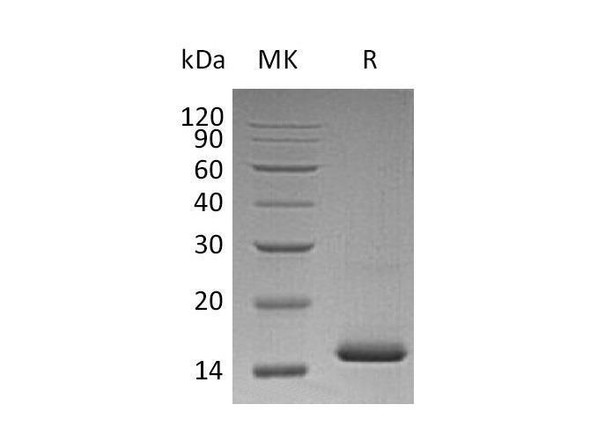Description
| Product Name: | Human VEGF Recombinant Protein |
| Product Code: | RPPB1065 |
| Size: | 10µg |
| Species: | Human |
| Target: | VEGF |
| Synonyms: | Vascular endothelial growth factor A, VEGF-A, Vascular permeability factor, VPF, VEGF, MGC70609. |
| Source: | HEK293 Cells |
| Physical Appearance: | Sterile Filtered White lyophilized (freeze-dried) powder. |
| Formulation: | The protein was lyophilized from a 0.2�M filtered solution of 20mM PB, 150mM NaCl, pH 7.2. |
| Solubility: | It is recommended to reconstitute the lyophilized Vascular Endothelial Growth Factor-HEK in sterile 18M-cm H2O not less than 100�g/ml, which can then be further diluted to other aqueous solutions. |
| Stability: | Lyophilized Vascular Endothelial Growth Factor HEK although stable at room temperature for 3 weeks, should be stored desiccated below -18°C. Upon reconstitution VEGF HEK should be stored at 4°C between 2-7 days and for future use below -18°C.For long term storage it is recommended to add a carrier protein (0.1% HSA or BSA).Please prevent freeze-thaw cycles. |
| Purity: | Greater than 95.0% as determined by SDS-PAGE. |
| Amino Acid Sequence: | APMAEGGGQN HHEVVKFMDV YQRSYCHPIE TLVDIFQEYP DEIEYIFKPS CVPLMRCGGC CNDEGLECVP TEESNITMQI MRIKPHQGQH IGEMSFLQHN KCECRPKKDR ARQENPCGPC SERRKHLFVQ DPQTCKCSCK NTDSRCKARQ LELNERTCRC DKPRR |
| Biological Activity: | Determined by the dose-dependent stimulation of the proliferation of human umbilical vein endothelial cells (HUVEC) using a concentration range of 4.0ng/ml, corresponding to a specific activity of 2.5 x 105 Units/mg. |
Vascular endothelial growth factor is an important signaling protein involved in both vasculogenesis and angiogenesis. As its name implies, VEGF activity has been mostly studied on cells of the vascular endothelium, although it does have effects on a number of other cell types (e.g. stimulation monocyte/ macrophagemigration, neurons, cancer cells, kidney epithelial cells ).VEGF mediates increased vascular permeability, induces angiogenesis, vasculogenesis and endothelial cell growth, promotes cell migration, and inhibits apoptosis. In vitro, VEGF has been shown to stimulate endothelial cell mitogenesisand cell migration. VEGF is also a vasodilator and increases microvascular permeability and was originally referred to as vascular permeability factor.Elevated levels of this protein are linked to POEMS syndrome, also known as Crow-Fukase syndrome. Mutations in this gene have been associated with proliferative and nonproliferative diabetic retinopathy.
Vascular Endothelial Growth Factor Human Recombinant produced in HEK293 cells is a double, glycosylated, polypeptide chain containing 165 amino acids (27-191) and having a molecular mass of 40 kDa. The VEGF is purified by proprietary chromatographic techniques.
| UniProt Protein Function: | Growth factor active in angiogenesis, vasculogenesis and endothelial cell growth. Induces endothelial cell proliferation, promotes cell migration, inhibits apoptosis and induces permeabilization of blood vessels. Binds to the FLT1/VEGFR1 and KDR/VEGFR2 receptors, heparan sulfate and heparin. NRP1/Neuropilin-1 binds isoforms VEGF-165 and VEGF-145. Isoform VEGF165B binds to KDR but does not activate downstream signaling pathways, does not activate angiogenesis and inhibits tumor growth. |
| NCBI Summary: | This gene is a member of the PDGF/VEGF growth factor family and encodes a protein that is often found as a disulfide linked homodimer. This protein is a glycosylated mitogen that specifically acts on endothelial cells and has various effects, including mediating increased vascular permeability, inducing angiogenesis, vasculogenesis and endothelial cell growth, promoting cell migration, and inhibiting apoptosis. Elevated levels of this protein is linked to POEMS syndrome, also known as Crow-Fukase syndrome. Mutations in this gene have been associated with proliferative and nonproliferative diabetic retinopathy. Alternatively spliced transcript variants, encoding either freely secreted or cell-associated isoforms, have been characterized. There is also evidence for the use of non-AUG (CUG) translation initiation sites upstream of, and in-frame with the first AUG, leading to additional isoforms. [provided by RefSeq, Jul 2008] |
| UniProt Code: | P15692 |
| NCBI GenInfo Identifier: | 17380528 |
| NCBI Gene ID: | 7422 |
| NCBI Accession: | P15692.2 |
| UniProt Secondary Accession: | P15692,O60720, O75875, Q074Z4, Q16889, B5BU86, H0Y2S8 H0Y407, H0Y414, H0Y462, H0Y8N2, H3BLW7, |
| UniProt Related Accession: | P15692 |
| Molecular Weight: | 34,406 Da |
| NCBI Full Name: | Vascular endothelial growth factor A |
| NCBI Synonym Full Names: | vascular endothelial growth factor A |
| NCBI Official Symbol: | VEGFA�� |
| NCBI Official Synonym Symbols: | VPF; VEGF; MVCD1�� |
| NCBI Protein Information: | vascular endothelial growth factor A; vascular permeability factor |
| UniProt Protein Name: | Vascular endothelial growth factor A |
| UniProt Synonym Protein Names: | Vascular permeability factor; VPF |
| Protein Family: | VEGF coregulated chemokine |
| UniProt Gene Name: | VEGFA�� |
| UniProt Entry Name: | VEGFA_HUMAN |










